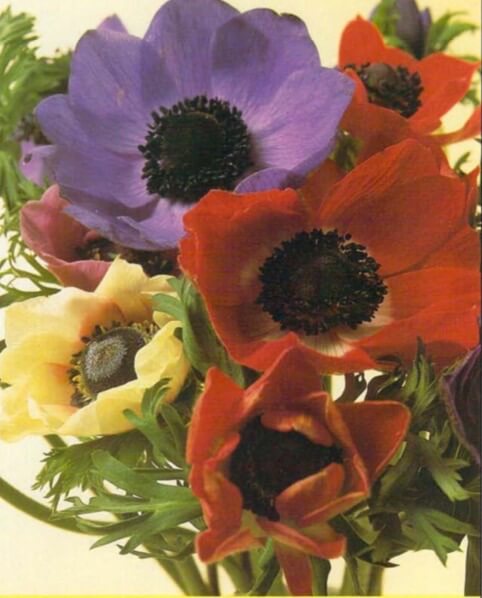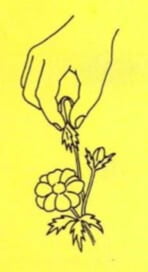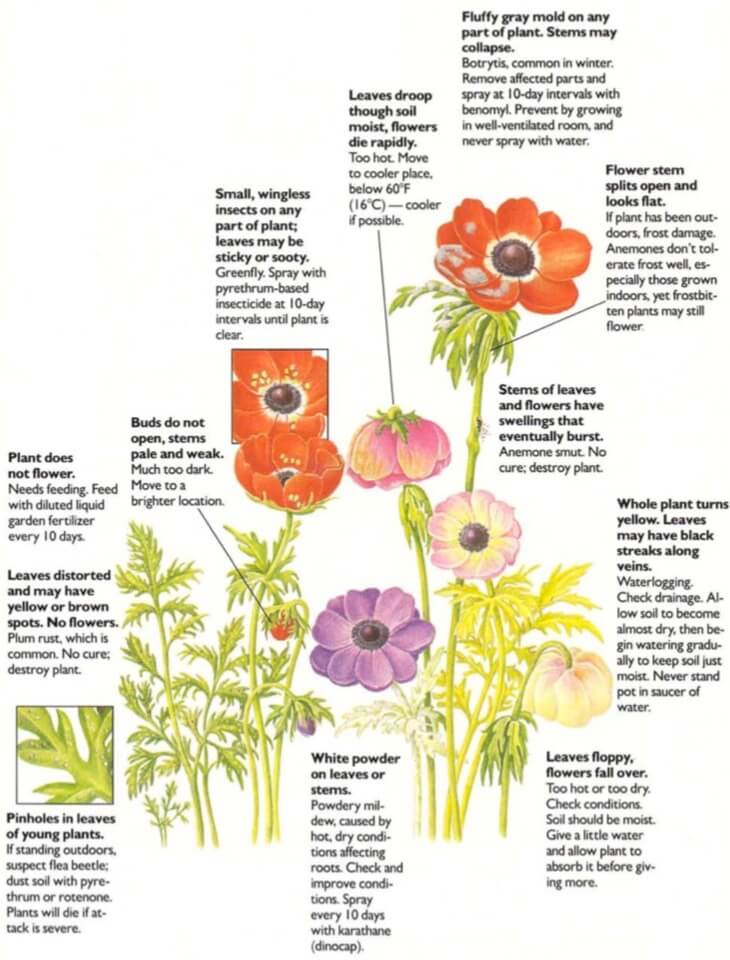[Ebook Việt Hoá] The Instant Guide to Healthy Houseplants (Hướng dẫn tức thời để chăm cây trong nhà khoẻ mạnh), Chi Anemone - Chi Phong Quỳ
[Ebook Việt Hoá] The Instant Guide to Healthy Houseplants: Anemone coronaria (Anemone)
- Nguồn: [Ebook Việt Hoá] The Instant Guide to Healthy Houseplants (Hướng dẫn tức thời để chăm cây trong nhà khoẻ mạnh)
- Biên tập: Dũng Cá Xinh
- Biên dịch: Team Codai.net
English
The anemone, also called the wind flower, can be grown either outside or indoors in pots, in which it will flower for up to 6 months. If growing from seed, sow in trays of potting soil in mid-spring. When seedlings are large enough to handle, prick off 5-6 plants for growing in an 8-in (20-cm) pot. Plants can also be raised from corms, and some garden centers sell young plants ready for planting or corms for potting in summer. If anemones are given good indoor conditions, especially good light, a pot of 5-6 plants will produce a , succession of up to 150 blooms.

Light
Needs full light at all times for healthy blooms. Shade seedlings from full sun.
Temperature
Flower production is best if constant temperature of 45°F (7°C) can be maintained, but plants will bloom at up to 60°F (16°C.)
Water
Soil must be moist and well drained. Water twice a week, more in very hot weather. Newly planted corms should be left almost dry for several days after potting.
Humidity
Cool, dry, well-ventilated loca- tion is essential. Do not spray, as wet foliage becomes vulner- able to fungal diseases.
Feeding
Once plants are growing strongly in pot, feed every 10 days with liquid garden fertilizer, every 5 days if in soilless media Dilute to manufacturer’s recommended strength.
Soil
Use loam-based soil o r soilless potting mix. Add equal amount of builder’s sand to assure good drainage .
After flowering
Remove dead flower heads to encourage new bud formation. Cut flower stem at soil level. When all flowering is finished and no new flower stems are visible, allow foliage to die back. Corms can be removed and dried for planting in the garden, but do not grow in pots again, as flowers will not be strong. Anemones are hardy outdoors only in southern states. In northern states, keep them indoors over winter, as the corms can’t tolerate cold.

What Goes Wrong

- Plant does not flower: Needs feeding. Feed with diluted liquid garden fertilizer every 10 days. and flowers have swellings that eventually burst. Anemone smut. No cure; destroy plant.
- Leaves distorted and may have yellow or brown spots. No flowers: Plum rust, which is common. No cure; destroy plant.
- Whole plant turns yellow. Leaves may have black streaks along veins: Waterlogging. Check drainage. Allow soil to become almost dry, then begin watering gradually to keep soil just moist. Never stand pot in saucer of water.: Pinholes in leaves of young plants. If standing outdoors, suspect flea beetle; dust soil with pyrethrum or rotenone. Plants will die if attack is severe.
- White powder on leaves or stems: Powdery mildew, caused by hot, dry conditions affecting roots. Check and improve conditions. Spray every 10 days with karathane.
- Leaves floppy, flowers fall over: Too hot or too dry. Check conditions. Soil should be moist. Give a little water and allow plant to absorb it before giving more.
- Buds do not open, stems pale and weak: Much too dark. Move to a brighter location
- Small, wingless insects on any part of plant; leaves may be sticky or sooty. Greenfly. Spray with pyrethrum-based insecticide at IO-day intervals until plant is clear.
- Leaves droop though soil moist, flowers die rapidly. Too hot. Move to cooler place, below 60°F (16°C)- cooler if possible.
- Fluffy gray mold on any part of plant. Stems may collapse: Botrytis, common in winter. Remove affected parts and spray at IO-day intervals with benomyl. Prevent by growing in well-ventilated room, and never spray with water.
- Flower stem splits open and looks flat: If plant has been out- doors, frost damage. Anemones don’t tolerate frost well, especially those grown indoors, yet frostbitten plants may still flower.
- Stems on leaves and flowers have swellings that eventually burst: Anemone smut. No cure; destroy plant.
Tiếng Việt
Dã quỳ hay còn gọi là “hoa gió” có thể trồng ngoài trời hoặc trong nhà, trong vòng 6 tháng cây sẽ ra hoa. Nếu trồng từ hạt, gieo vào khay đất giữa mùa xuân. Khi cây con đủ lớn, giâm 5-6 cây để trồng trong chậu khoảng 8 inch (20 cm). Cây cũng có thể phát triển được trong vỏ thân hành, và một số trung tâm vườn ươm có bán cây non để trồng hoặc vỏ thân hành để làm chậu vào mùa hè. Nếu hải quỳ được đặt trong điều kiện trong nhà tốt, đặc biệt là ánh sáng tốt, một chậu có 5-6 cây sẽ cho ra một chùm hoa liên tiếp lên đến 150 bông.

Ánh sáng
Cần ánh sáng đầy đủ mọi lúc để hoa nở khỏe mạnh. Che nắng cho cây con.
Nhiệt độ
Sản lượng hoa tốt nhất nếu có thể duy trì nhiệt độ ổn định 45 ° F (7 ° C), nhưng cây sẽ nở hoa ở nhiệt độ lên đến 60 ° F (16 ° C).
Nước
Đất phải ẩm và thoát nước tốt. Tưới nước hai lần một tuần, nhiều hơn khi thời tiết quá nóng. Cây mới trồng trong vỏ thân hành nên để khô trong vài ngày sau khi đặt vào chậu.
Độ ẩm
Vị trí thoáng mát, khô ráo, thông thoáng là điều cần thiết. Không phun ẩm vì tán lá ẩm ướt sẽ dễ bị nấm bệnh.
Bón phân
Khi cây đang phát triển mạnh trong chậu, hãy bón phân 10 ngày một lần bằng phân bón vườn dạng lỏng, 5 ngày một lần nếu trong môi trường không có đất. Pha loãng theo liều lượng khuyến cáo của nhà sản xuất.
Đất
Sử dụng đất mùn và hỗn hợp bầu không cần đất. Thêm lượng cát xây dựng bằng nhau để đảm bảo thoát nước tốt.
Sau khi ra hoa
Loại bỏ những đầu hoa đã chết để kích thích hình thành chồi mới. Cắt cành hoa ngang với đất. Khi hoa nở hết và không nhìn thấy cành hoa mới, hãy để cho các tán lá chết trở lại. Có thể mang vỏ thân hành ra phơi khô để trồng ngoài vườn, nhưng không nên trồng lại trong chậu vì như vậy hoa sẽ không bền. Dã quỳ chỉ sống ngoài trời ở các bang miền nam. Ở các bang phía bắc, hãy trồng chúng trong nhà qua mùa đông, vì vỏ thân hành không thể chịu được lạnh.

Những vấn đề có thể xảy ra

- Plant does not flower: Needs feeding. Feed with diluted liquid garden fertilizer every 10 days. and flowers have swellings that eventually burst. Anemone smut. No cure; destroy plant.
- Leaves distorted and may have yellow or brown spots. No flowers: Plum rust, which is common. No cure; destroy plant.
- Whole plant turns yellow. Leaves may have black streaks along veins: Waterlogging. Check drainage. Allow soil to become almost dry, then begin watering gradually to keep soil just moist. Never stand pot in saucer of water.: Pinholes in leaves of young plants. If standing outdoors, suspect flea beetle; dust soil with pyrethrum or rotenone. Plants will die if attack is severe.
- White powder on leaves or stems: Powdery mildew, caused by hot, dry conditions affecting roots. Check and improve conditions. Spray every 10 days with karathane.
- Leaves floppy, flowers fall over: Too hot or too dry. Check conditions. Soil should be moist. Give a little water and allow plant to absorb it before giving more.
- Buds do not open, stems pale and weak: Much too dark. Move to a brighter location
- Small, wingless insects on any part of plant; leaves may be sticky or sooty. Greenfly. Spray with pyrethrum-based insecticide at IO-day intervals until plant is clear.
- Leaves droop though soil moist, flowers die rapidly. Too hot. Move to cooler place, below 60°F (16°C)- cooler if possible.
- Fluffy gray mold on any part of plant. Stems may collapse: Botrytis, common in winter. Remove affected parts and spray at IO-day intervals with benomyl. Prevent by growing in well-ventilated room, and never spray with water.
- Flower stem splits open and looks flat: If plant has been out- doors, frost damage. Anemones don’t tolerate frost well, especially those grown indoors, yet frostbitten plants may still flower.
- Stems on leaves and flowers have swellings that eventually burst: Anemone smut. No cure; destroy plant.
![[Ebook Việt Hoá] The Instant Guide to Healthy Houseplants: Anemone coronaria (Anemone) [Ebook Việt Hoá] The Instant Guide to Healthy Houseplants: Anemone coronaria (Anemone)](https://vn1.vdrive.vn/codai.net/2020/02/ebook-huong-dan-tuc-thoi-cham-cay-trong-nha-khoe-manh-58-anemone-coronaria.jpg)


